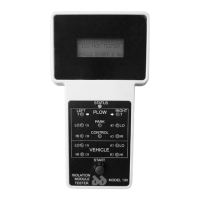
Do you have a question about the Douglas Dynamics 29070-1 and is the answer not in the manual?
| Brand | Douglas Dynamics |
|---|---|
| Model | 29070-1 |
| Category | Test Equipment |
| Language | English |
Provides detailed instructions for operating the isolation module tester.
Important safety notice advising users to read the document before use.
Defines hazard symbols (WARNING, CAUTION) and notes for user safety.
Lists critical safety warnings and precautions for operation and maintenance.
Information on fuse types, ratings, and replacement for snowplow systems.
Personal safety rules to follow during vehicle and snowplow service.
Safety measures to prevent injury when working with vehicle batteries.
Instructions for connecting the tester to a 110V AC outlet or 12V vehicle battery.
Guide on connecting the tester harness to the isolation module ports.
How to select between default and specific test cycles for isolation modules.
Understanding pass/fail indicators and identifying failed components.
Overview of tests performed and how they are indicated on the tester.
Lookup table for display codes and their corresponding failure types.